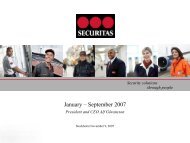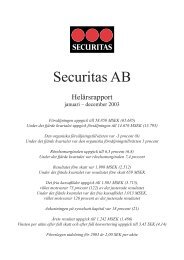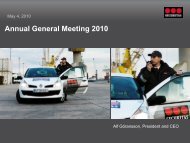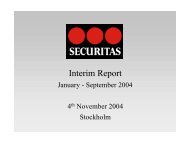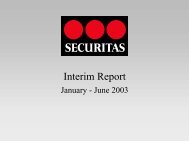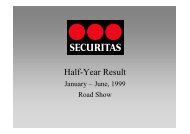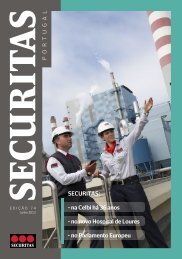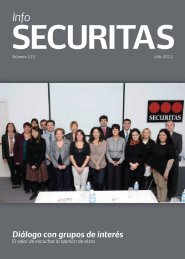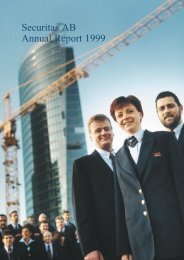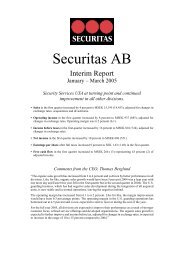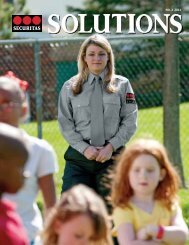Annual Report 2008 - Securitas
Annual Report 2008 - Securitas
Annual Report 2008 - Securitas
Create successful ePaper yourself
Turn your PDF publications into a flip-book with our unique Google optimized e-Paper software.
128<br />
Corporate Governance<br />
Board of Directors report on corporate Governance and Internal control<br />
Internal Control<br />
Description of Internal Control and Risk Management<br />
According to the Swedish companies Act and the Swedish code<br />
of corporate Governances, the Board of Directors is responsible<br />
for the internal control and risk management. This report has been<br />
prepared in accordance with the Swedish code of corporate<br />
Governance, and is therefore limited to internal controls over<br />
financial reporting. This description does not form a part of the<br />
<strong>Annual</strong> report.<br />
<strong>Securitas</strong>’ system of internal control is designed to manage<br />
rather than eliminate risk of failure to achieve business objectives<br />
and can only provide reasonable and not absolute assurance<br />
against material financial reporting misstatement or loss.<br />
Loomis was part of the <strong>Securitas</strong> Group until December 8,<br />
<strong>2008</strong> and thus also important from an Internal controls perspective.<br />
Loomis’ system of internal control was based on <strong>Securitas</strong>’<br />
governance framework but additional areas and control activities<br />
were included to accommodate the distinctive characteristics and<br />
risks of its business.<br />
Control Environment<br />
The Group has established a governance framework. The key<br />
features of the control environment within the framework include:<br />
the clear terms of reference for the Board and each of its committees,<br />
a clear organizational structure, with documented delegation<br />
of authority from the Board to Group Management, the quality of<br />
employees and a series of Group policies, procedures and frameworks.<br />
Overall the Group operates in a flat and specialized organization<br />
whereby managers are given clear objectives and are authorized<br />
to make their own decisions and develop their operations close to<br />
the customers. For more information on the management model<br />
refer to pages 34–35. Delegation of authority is documented in<br />
an approval matrix that provides a clear direction for managers at<br />
all levels.<br />
Emphasis is placed on the quality and abilities of the Group’s<br />
employees with continuing education, training and development<br />
actively encouraged through a wide variety of schemes and programs.<br />
The Group has adopted a set of values to act as a framework<br />
for its people to exercise judgment and make decisions on<br />
a consistent basis.<br />
The Group’s major financial policies, procedures and frameworks<br />
include a comprehensive manual, Group Policies and Guidelines,<br />
a <strong>Report</strong>ing Manual, <strong>Securitas</strong> model for financial control (for more<br />
detailed information on the model refer to pages 36–37), a Group<br />
Treasury Manual and the IT Security Manual. These are all periodically<br />
reviewed and updated.<br />
Risk Assessment<br />
At the highest level, the Board considers where future strategic<br />
opportunities and risks lie and helps shape the corporate strategy<br />
going forward. Accountabilities for managing risks are clearly<br />
assigned to the Group, Divisional and local management. The<br />
Group Management team has the day-to-day responsibility for<br />
<strong>Securitas</strong> <strong>Annual</strong> report <strong>2008</strong><br />
the identification, evaluation and management of risks and for the<br />
implementation and maintenance of control systems in accordance<br />
with the Board’s policies. Specifically Divisional Management<br />
and established functional committees have the responsibility to<br />
ensure that there is a process throughout the division to create<br />
risk awareness. Operating unit managers and country risk managers<br />
are responsible for ensuring that risk management is part of<br />
the local corporate culture at all levels within a country.<br />
The Group has an established, but evolving, system of business<br />
risk management, which is integrated into the Group’s business<br />
planning and performance monitoring processes regardless<br />
whether it is financial, operational or compliance risks.<br />
Additionally, business risk reviews and risk reviews are conducted<br />
routinely throughout the Group. Procedures exist to ensure<br />
that significant risks and control failures are escalated to Group<br />
Management and the Board, as necessary, on a periodic basis.<br />
For more information on risk management refer to pages 38–41.<br />
Control Activities<br />
Internal control covers all divisions and subsidiaries in the Group<br />
and includes methods and activities for securing assets, controlling<br />
the accuracy and reliability of internal and external financial<br />
reports and ensuring compliance with defined guidelines.<br />
1. Self Assessment<br />
Every operating unit throughout the Group annually performs a<br />
control self assessment of the compliance with Group Policies<br />
and Guidelines, the reporting Manual and the IT Security Manual.<br />
An extensive questionnaire is used to measure to what extent<br />
defined requirements are fulfilled. The control self assessment is<br />
signed off by the President and the Controller within each entity.<br />
As a part of the process, the external auditor performs a validation<br />
of the answers given in the questionnaire for questions<br />
deemed as risk areas. Answers are compiled at divisional level as<br />
well as at a Group level in order to support benchmarking within a<br />
division or between divisions. reported deviations include written<br />
comments on planned improvements to address deviations<br />
and a deadline for when planned actions will be in place. All reports<br />
are made available to Divisional Management, Group Management<br />
and the Audit committee.<br />
2. Risk and Control Diagnostics<br />
The Group performs risk and control diagnostics in functional areas<br />
which by nature have high inherent risk, the diagnostics are done in<br />
addition to the recurring areas of the self assessment questionnaire.<br />
For <strong>2008</strong> specific focus has been placed on new countries<br />
in the Group rather than a specific function, since this has been<br />
assessed as a risk area in terms of integration from a financial<br />
reporting and control standpoint due to recent acquisition activities.<br />
The diagnostic entails a “kit” covering IFrS reporting compliance<br />
as well as key controls within financial processes and IT security.<br />
The findings from these diagnostic reviews are presented to<br />
Group Management and the Audit committee.



